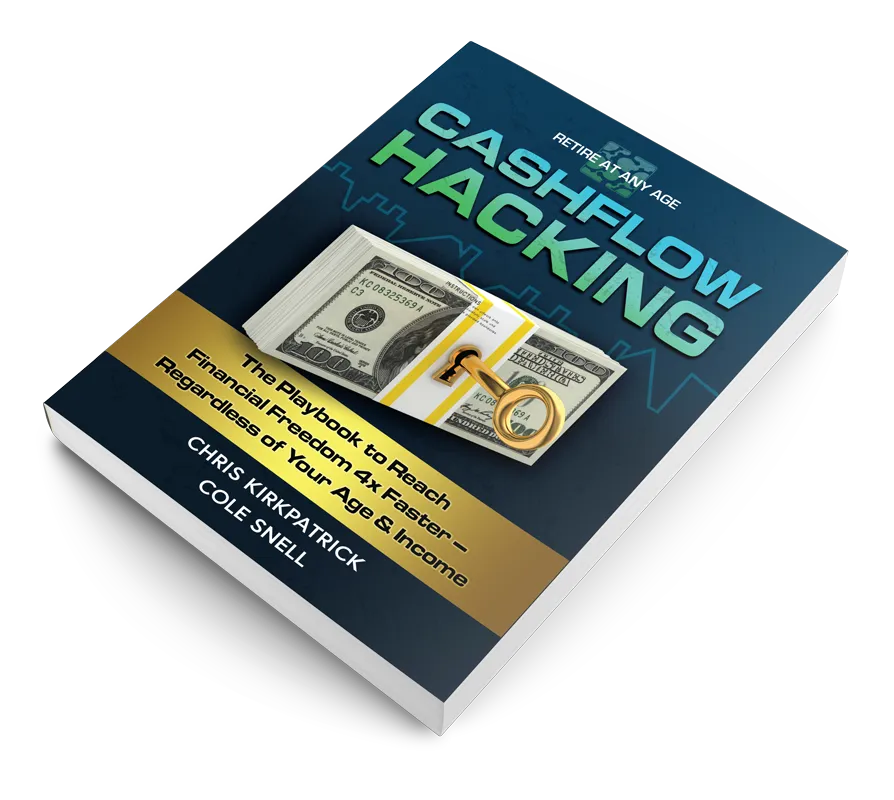
Simplifying Financial Confusion
LEARN CASH FLOW HACKING TO REACH FINANCIAL FREEDOM
Used by 90% of millionaires to reach their financial goals 4x faster

Achieve Financial Freedom Through Cash Flow Hacking

Increase Your Lifestyle While You Build Your Wealth

Position Yourself to Thrive in Market Downturn
YOU SHOULD NOT FEEL OUT OF CONTROL ABOUT YOUR FINANCIAL STRATEGY

Have easy access to your money in case of emergencies and opportunities

Use the investment strategy 90% of millionaires use

You deserve a clear plan to consistently grow your money and avoid market uncertainty

Have a guide and advisor that has your best interest in mind

Do not overpay in taxes

Stop guessing at the best vehicles to protect and grow your money

Expert Advice: Understanding Whole Life Insurance
This article is a written adaptation of the video featured on our YouTube channel, LIFE180. Check it out for more insights!
Intro To Facts You Need To Know About Whole Life Insurance
In this article, we’ll discuss 10 important facts about whole life insurance that everyone should understand before making a purchasing decision. If you’re familiar with the content on our LIFE180 YouTube channel, you’ll know that I’m a strong advocate of using a diverse portfolio of life insurance products. While I have a deep appreciation for whole life insurance, I don’t believe it’s always the best starting point for everyone.
There are many people out there promoting infinite banking and whole life insurance as a one-size-fits-all product that will solve all your financial needs, often labeling it as a "secret tool of the wealthy." I’m here to tell you that it’s not. While I don’t believe it’s some hidden financial secret or a universal solution, I do love whole life insurance.
In fact, I consider it one of the most versatile assets available, and I believe everyone should incorporate it into their financial strategy at some point. The real question is: when is the right time?
By the time you finish reading this article and gain an understanding of the key facts about whole life insurance (how it works, its advantages, disadvantages, potential pitfalls, and common mistakes) I believe you’ll be better equipped to make an informed decision.
Ultimately, the goal is to ensure that you never invest your money in something you don’t fully understand. That’s what this is all about: empowering you to make the best possible decision for your financial future.
By the end of this article, I hope you’ll have gained more clarity on these topics. If you find value in this content, I encourage you to subscribe and hit the notification bell on our LIFE180 YouTube channel, so you’ll be notified whenever I release new material.
I publish videos and articles like this almost every day, with a focus on in-depth education about personal finance and life insurance as a valuable asset for achieving your financial goals. I don’t think you’ll find another resource offering this level of free, comprehensive education on these subjects anywhere online. So, without further ado, let’s dive in.
Whole Life Insurance Is A FIxed Product
The first fact I want to highlight about whole life insurance is that it’s a fixed product. There are many types of fixed products in the financial space, including indexed universal life and whole life insurance, which both fall under this category. Indexed annuities are also considered fixed products. Essentially, if someone holds a life insurance license, they are authorized to sell fixed products.
Fixed products typically offer some form of guarantee, meaning there aren’t many variables involved. Unlike riskier investments such as mutual funds or equities, where you can lose a significant amount of money, fixed products are designed to limit exposure to market risk.
This is where some criticism arises with indexed universal life insurance, as it carries more risk than other fixed products. The challenge is that these policies are often marketed as though they don’t have that additional risk, which can lead to misconceptions.
With whole life insurance, it’s crucial to understand that because it’s a fixed product, you have a fixed premium. This can be both a positive and a negative. The benefit of a fixed premium is that, as long as you continue making payments, it represents a binding contract with the insurance company.
Think of the life insurance company as a business partner in this agreement. When you sign with a participating, mutually-held life insurance company, you become the beneficiary of that contract. From that moment forward, as long as you make your premium payments, the company is obligated to fulfill its promises to you and honor the terms of the contract.
With Whole Life Insurance, You Are Partnering With The Insurance Company
From this perspective, you’re essentially partnering with the life insurance company, as you’re effectively a shareholder. This is why it’s important to work with a participating, mutually-held company rather than just any mutual company.
Many companies, such as State Farm and Allstate, are mutual companies, but they are not participating mutual companies. As a result, you don’t receive the same level of dividends, nor do you have the flexibility to structure and use your policy in the way we advocate. To recap, fact number one is that whole life insurance is a fixed product, and as long as you pay your premiums, your policy will remain in place. This brings us to fact number two.
Whole Life Insurance Is More Flexible Than Most People Think
Fact number two is that whole life insurance, despite having a fixed premium, is actually more flexible than most people realize. A common criticism of whole life insurance is its perceived rigidity, many assume that a fixed premium means you're stuck with that payment amount. However, if the policy is designed correctly, you can actually build in a significant amount of flexibility around the premium.
For example, if I structure a policy with a 40/60 blend (40% going to the base premium and 60% toward paid-up additions (PUAs)) and I include a term rider to inject more cash value early on, this creates flexibility in premium payments. The 40% base premium is required, but the 60% allocated to paid-up additions is not mandatory on an annual basis. So, what does that mean?
This means that if I have a total premium of $20,000 structured as 40% base and 60% paid-up additions, then $8,000 is allocated to the base premium and $12,000 to the paid-up additions. The beauty of the paid-up additions is that the $12,000 isn’t a required annual payment.
Typically, there’s an annual fee for the paid-up additions rider—around $120. So, to keep it simple, my minimum payment would be approximately $8,120, which includes the $8,000 base premium plus the $120 rider fee. This is where the flexibility you need and the choice of company come into play.
It’s essential to choose companies that offer this kind of flexibility because, to be straightforward, not every insurance company allows you to skip the $12,000 payment and then pay it back the following year. Some companies may not permit you to consistently fund the policy with the full $20,000 premium each year, so careful selection is crucial to ensure you have the options you need.
Some companies allow you to make up missed payments in subsequent years. For instance, if I have a $20,000 premium with $12,000 allocated to paid-up additions, and there’s a year when I either don’t need or can’t make that payment, I can simply pay the $8,000 base premium.
Then, in the following year, I could pay the full $20,000, including the $12,000 I missed from the previous year, effectively making up for the missed premium. However, it’s important to note that not every company will allow this flexibility.
This is why, depending on your circumstances, needs, cash flow, and the predictability of that cash flow, it's crucial to evaluate your options carefully. In the insurance business, there’s never a free lunch; every choice involves costs and trade-offs. However, each cost comes with its own value.
You need to clarify what you expect from the policy in terms of guarantees, flexibility, potential upsides, loan provisions, and other factors. Even though whole life insurance has a fixed premium, as we discussed in fact number one, it actually offers more flexibility than you might think.
Whole Life Insurance Provides Access To Cash Value
Fact number three is that whole life insurance includes a cash value component. Building on what we discussed in fact number two, the policy consists of a base premium and paid-up additions. Both of these elements contribute to the accumulation of cash value over time.
The higher your base premium, the slower the cash accumulation will be. Critics of whole life insurance, such as Dave Ramsey and Suze Orman, often point out that a policy with a 100% base premium can take 12 to 15 years before any significant cash value accumulates.
However, when we implement the blended policy structures we teach and promote, we enable individuals to enhance their real estate portfolios, improve their emergency funds, create a volatility buffer for retirement, and establish capital reserve funds for their businesses. By doing this, we can achieve higher early cash value and greater liquidity for various uses throughout your life.
Having a cash value component is incredibly valuable, but it’s important to recognize that not every company or policy design is the same. You need to ensure that the insurance company, the policy design, and the agent you work with are all aligned with your specific needs, values, beliefs, and concerns. Understanding the problems you’re trying to solve (what your actual needs and wants are) allows for a customized approach.
Every policy should be tailored to fit your unique circumstances.
You Can Use Whole Life Insurance Dividends In Many Ways
Fact number four is that whole life insurance policies pay dividends. The exciting part about these dividends is that you have various options for utilizing them. You can take them as income during retirement or use them to purchase paid-up additions, which enhances the liquidity within your policy.
One of the most interesting aspects of dividends, and also one of the most commonly misrepresented by critics like Dave Ramsey, is that they are paid to you as a return of premium. At first glance, this might sound negative, like you’re simply overpaying for your policy and receiving some of your premium back. However, this perspective can be misleading.
Critics like Dave Ramsey and Suze Orman often argue against whole life insurance by suggesting that if dividends are merely a return of premium, it means you're overpaying for your policy. However, this perspective overlooks an important detail: the return of premium structure is what allows you to maintain the tax benefits associated with the dividends in your whole life insurance policy. Without this structure, you would lose those valuable tax advantages.
Here’s where it gets even better: the return of premium is not just about receiving your premium back; it also includes a share of the company’s profitability. When you work with a participating mutual company, you essentially become a shareholder, similar to how you would hold shares in a publicly traded company. This means you have a stake in the company's success, which can lead to greater financial benefits over time.
As a policyholder, you participate in dividends based on the overall profitability of the insurance company. Life insurance companies generate profits from a variety of sources, including whole life policies, term life insurance, annuities, and other investment products through their general fund. Your return of premium comes from the entire book of business that the company manages, not just from your individual policy. This broader participation can lead to more substantial dividends over time.
If you look into the statistics, you'll find that term life insurance policies are paid out only 0.9% of the time, making them one of the most profitable segments for life insurance companies. Indexed Universal Life (IUL) and term life insurance are among the most lucrative products for these companies.
As a participating policyholder with a whole life policy from a mutually held company, you benefit from the profitability of all their business lines, be it term insurance, annuities, or other products. When these segments perform well, you share in that success through dividends paid to you.
You also participate in the success of the insurance company’s general fund returns. This success arises from their skill in managing investments effectively, which includes various bond portfolios, real estate holdings, and other assets. Moreover, you reap the benefits of the overall profitability of the company’s entire book of business, not just from your specific policy.
The perception of dividends being paid as a return of premium is often framed negatively, but in reality, it is one of the most advantageous aspects of whole life insurance. This structure not only provides tax benefits but also allows you to partner with some of the most successful financial institutions in history.
Many participating mutual companies have maintained impeccable track records, having never missed a dividend payment in over 110 years. In fact, some have achieved this remarkable consistency for as long as 150 years. That’s a testament to their reliability and stability in the financial market.
We must recognize the value of partnering with a company that consistently fulfills its promises, even during challenging economic times such as the Great Recession, the Great Depression, and even through periods of civil unrest. Whole life insurance is not just an investment; it serves as a secure place to store capital and a viable banking alternative.
This is why we emphasize its importance. By keeping your money in such a stable environment, you benefit from dividend payments that provide liquidity, usage, and control over your funds. This adaptability is truly powerful, allowing you to navigate various economic conditions with confidence.
Guarantees Matter With Life Insurance - Using A Bank vs Whole Life Insurance
Fun fact number five: guarantees matter. Whole life insurance offers a guaranteed death benefit, which is crucial to understand. While some advocate for Indexed Universal Life (IUL) as a great wealth-building tool or suggest focusing solely on cash value, especially in infinite banking strategies, I’m here to tell you the death benefit absolutely matters. It’s not just about cash value; the guaranteed death benefit plays a key role.
The way I see it, whole life insurance allows us to essentially "buy" our net worth while building cash flow. For example, I could put my money into a high-yield savings account earning around 4.5%, or I could invest it into a whole life insurance policy that, over time, will generate similar returns of about 4.5%.
Now, what’s the main difference? The key difference, though I'll mention another one shortly, is the death benefit. That’s the big advantage. Let’s say I’m saving $10,000 a year, not as an investment, but for an emergency fund, an opportunity fund, or operating capital for a business, money I need to keep liquid. The main difference between putting that money in a savings account versus a whole life insurance policy is the death benefit. In the long term, both will perform fairly similarly.
In the short term, the savings account will outperform because it doesn’t have the insurance costs and fees. However, if you adopt a long-term mindset (thinking four, five, six, or seven-plus years out) whole life insurance will ultimately outperform anything a savings account can offer.
If I were to save $10,000 a year in a regular bank account, after 10 years I would likely have accumulated around $110,000 to $120,000. Upon my death, my heirs, business partners, or whoever is designated as my beneficiary would receive that sum. However, if that same amount of money is saved in a whole life insurance policy, I would still have access to the same $110,000 to $120,000 during my lifetime. But the crucial difference is that, upon my death, the policy would "self-actualize," meaning it would fully execute and complete the financial plan, ensuring my beneficiaries receive significantly more than just the saved amount.
It’s a self-completing plan that ensures, when I die (or if I die, though hopefully not anytime soon) that my beneficiaries won’t just receive the $110,000 I’ve saved. Thanks to the use of paid-up additions, that $110,000 could actually grow to $800,000 or even $1 million, depending on how the policy is structured, my age, and other variables. There’s a powerful multiplication effect at play here, which significantly increases the benefit over time.
That’s why I refer to it as a self-completing plan, and why I believe it’s so powerful. We’ve discussed the concept of "buying your net worth" and building your cash flow, saving money is a way to create opportunities for investment. But if something tragic happens, you need to ensure that both you and your net worth are protected.
When I say "buying your net worth," I’m referring to the death benefit, which guarantees that if I’m unable to save and build my cash flow for long enough, everything I’ve been working toward automatically self-completes. In contrast, with a regular bank account, while the long-term cash value might be similar, a life insurance policy offers the added component of self-completion. This not only benefits my heirs, but also my family and business partners. To me, it’s the most obvious choice.
Whole Life Insurance Provides More Flexibility and Control Long Term Than IUL
Fact Number Seven: Whole Life Insurance is More Flexible. We touched on this concept earlier, but I want to explore the idea of flexibility from a different perspective.
One common challenge is that Indexed Universal Life (IUL) and whole life insurance are often compared. Many people claim that IUL is a newer, more improved version of whole life insurance, but in reality, it’s quite the opposite. When you place your money into an IUL contract, you are essentially surrendering control to the insurance company.
In contrast, when you put your money into a whole life insurance contract, you retain full control, and the insurance company is obligated to fulfill its commitments to you. This is the opposite of an IUL, where you are responsible for meeting the obligations to the insurance company, and yet, the company holds the legal right to modify the terms of the contract.
That’s the true power of whole life insurance compared to an IUL. Now, from a flexibility standpoint, there’s another key advantage: you can fully pay up a whole life insurance policy in as little as seven years. This is a significant benefit. After the seven-year mark, you can utilize strategies like premium offset, where you use partial surrenders and dividends to cover the premiums.
This approach allows you to maintain the policy’s living benefits without having to pay out of pocket, which can be an incredibly powerful way to continue funding the policy while enjoying its full range of benefits.
Another key feature is the option to convert your policy into what's called a reduced paid-up policy. Let’s say your circumstances change, maybe you no longer need as much death benefit, or you value it less because your life and cash flow have evolved. Even if you still value the death benefit, you might not want to be obligated to continue making premium payments.
After the seventh year, you have the flexibility to reduce the death benefit and fully pay up the policy. But what does it mean to "pay up the policy"? Essentially, it means you no longer have to worry about insurance costs or fees, your policy is fully funded, and you retain the benefits without ongoing payments.
At this point, you now have a fully paid-up policy with both cash value and a death benefit, where dividends will continue to accumulate. All the benefits we've discussed so far remain intact, the policy will keep growing and compounding, and you’ll still have liquidity, use, and control over the money. Best of all, all the fees and expenses are taken care of, allowing you to fully enjoy the policy’s advantages without further payments.
The key difference between a whole life policy and an IUL is that with whole life, you can fully pay up the policy, leaving you with no more fees or ongoing costs. In contrast, IULs use something called "vanishing premiums." While vanishing premiums may look appealing on an illustration, don’t be fooled, there are still fees operating behind the scenes in an IUL.
With an IUL, what’s actually happening is that it's not truly permanent insurance. It operates on an annual renewable term chassis, which is the foundation of all Universal Life policies, combined with an options strategy that allows participation in an index. While IULs are often touted as being more flexible due to vanishing premiums (giving you the option not to pay premiums every year) this flexibility is somewhat limited. While it may seem like a bit more flexibility compared to whole life, it’s not as significant as many people believe.
The problem with this supposed flexibility is that it comes with both cost and risk. Growing up, I was always taught that just because you can do something doesn’t mean you should. This is especially true with Indexed Universal Life. The very flexibility that’s often promoted as its greatest advantage is what tends to cause the most trouble for policyholders. When agents illustrate IUL policies with vanishing premiums after seven, ten, or even twenty years, the hidden fees in the background don’t disappear, they continue to accumulate, often catching people off guard.
Unless you're an expert who knows how to carefully dissect these illustrations (especially when they include income projections) it’s nearly impossible to make sense of the information. Without a deep understanding, most people find it difficult to truly grasp what’s happening behind the scenes with an IUL policy.
One of the greatest advantages of whole life insurance is its flexibility. After seven years, you have the option to fully pay up the policy, which is a powerful feature. One of my favorite aspects of Whole Life is the control it provides over our money and financial goals. It allows us to manage our insurance costs on a guaranteed basis, where we are in control, not the insurance company.
This level of control is a major reason why I’m such a strong advocate for whole life insurance. While paying up the policy is an option at any point after year seven, it’s not always the ideal strategy. In fact, in most cases, I wouldn’t recommend it.
I dive into this topic in more detail in other content, so be sure to subscribe and hit the bell on our LIFE180 YouTube channel to get notified when those videos are released. Even though it’s not always advisable, having the option to fully pay up the policy gives you additional flexibility and control.
Whole Life Insurance Has Living Benefits To Help With Medical Issues
An important feature of whole life insurance is its living benefits. While I’ve already covered the advantages like the death benefit and the cash value component, which can outperform a traditional savings account in the long run, it’s worth noting that whole life insurance offers more than just protection for your beneficiaries. Beyond the security of the death benefit, there are also living benefits, which provide financial advantages during the policyholder’s lifetime.
One of the standout features of whole life insurance is the availability of accelerated benefit riders. These riders are designed to provide support if you face critical, chronic, or terminal illness. In such cases, you can access a portion of the death benefit early (completely tax-free) while you’re still alive. This adds a layer of financial security, offering peace of mind during challenging times.
To illustrate the impact of these living benefits, let me share a personal story. My father-in-law was diagnosed with stage four pancreatic cancer, which is notoriously one of the deadliest forms of cancer. By the time he received the diagnosis, the doctors gave him just 90 days to live. They discovered a 7.5-centimeter tumor on his pancreas that had already spread to his liver. The prognosis was grim. While the oncologist mentioned that treatment could possibly extend his life, the quality of that extended time would be very poor.
Thanks to the living benefits provided by his whole life insurance policy, we were able to access significant capital during a critical time. The ability to tap into a portion of the death benefit while he was still alive allowed us to secure multiple six figures, which helped fund alternative treatments.
Today, nearly four years after his initial diagnosis, my father-in-law is thriving. He plays golf four times a week, enjoys trips to the Dominican Republic, and spends time with his grandchildren.
Had we followed the conventional medical treatments as originally suggested, it's likely that he wouldn’t be with us today. By leveraging the financial flexibility provided by his policy, we were able to take control of his medical decisions and explore alternative treatments. In doing so, we took a proactive approach to his care, putting ourselves in a position of greater control over the outcome.
When I talk about the control that life insurance offers, this is a prime example. It’s not just about having control over your money, it's about having control over the decisions you make throughout life. While the death benefit is valuable in determining what happens to your finances after you’re gone, whole life insurance also empowers you to manage your money while you're still alive.
The flexibility it provides can be life-saving, offering financial resources not only for your beneficiaries but for your own well-being as well. That, to me, is a significant advantage.
Now, let’s break down how accelerated benefit riders work. If you become critically, chronically, or terminally ill, each insurance company handles these riders a bit differently. This brings us back to the earlier discussion about the variations in paid-up additions riders and the flexibility they offer. Every policy can have unique features, so it’s important to understand how your specific plan operates.
Your choice of insurance company will depend largely on how important living benefits are to you. Different companies offer varying accelerated benefit riders, each with distinct terms and conditions. This is why it's crucial to carefully evaluate these differences when selecting a policy. Understanding how each company's riders function and the specific use cases they cover will help you make an informed decision tailored to your needs.
Typically, if you are diagnosed with a terminal illness, most companies will accelerate a portion of the death benefit. Depending on the insurer, this can happen within either 12 or 24 months of the diagnosis. What’s particularly beneficial is that you have complete freedom in how you use these funds, you don’t need to justify or specify how the money will be spent.
I’ve had clients in the past who chose to use their accelerated benefits in different ways. About a decade ago, one client, also diagnosed with pancreatic cancer, decided not to pursue treatment. Instead, she used the funds to take her family on a final vacation and enjoy her last few months.
That’s the kind of flexibility these benefits provide. If you're diagnosed with a terminal illness, lose two of the six activities of daily living, or become cognitively impaired, you can typically access a portion of the death benefit early. This empowers you to take control of your medical decisions during retirement, giving you the freedom to manage your care and quality of life on your terms.
Another significant benefit of whole life insurance is the financial protection it offers in retirement, especially against medical-related issues. In the U.S., 70% of bankruptcies during retirement are due to medical expenses.
This is where whole life insurance becomes invaluable, not just for ensuring that your death benefit is secure or that the accelerated benefit riders can help you during a health crisis, but also as a safeguard for your overall financial stability.
By providing a financial backstop, this policy can help prevent medical issues from derailing your retirement plan and protect you from the high costs that often arise in later life.
Whole Life Insurance Provides Tax Benefits - Tax Deductions vs Tax Deferrals
Fact number nine about whole life insurance is the extensive tax benefits it offers. Whether it’s the tax-free death benefit paid to your heirs, the tax-deferred growth of the policy’s cash value, or the tax-free access through policy loans, these advantages are often overlooked.
Whole life insurance provides a unique opportunity to leverage tax benefits in ways many people aren’t even aware are possible, offering financial flexibility both during life and after. A common mistake I discuss with people is how they think about taxes, especially in relation to tax deferral. Many focus on deferring taxes rather than truly reducing their tax burden.
When it comes to qualified plans like 401(k)s, 457s, or 403(b)s, what people often overlook is that these plans don't provide a tax deduction, they simply defer taxes to a later time. This distinction is crucial when planning for long-term financial health.
When we consider the broader economic landscape (national debt, government debt, unfunded liabilities, rising interest rates, and inflation) all signs point to one conclusion: taxes are likely to increase. Every indicator suggests that future tax rates will have to rise to address these financial pressures. This reality makes it even more important to carefully plan how you manage your money and tax exposure.
We are currently in one of the lowest tax rate environments the U.S. has seen in decades, and it has stayed that way for quite some time. Given the current economic conditions, it seems almost inevitable that taxes will have to rise in the future. So, why defer taxes now only to face potentially higher tax rates later? From my perspective, it doesn’t make sense to avoid paying taxes today, only to pay more down the road.
While many people find it difficult to accept paying taxes now, the reality is that there's no avoiding taxes altogether. Whether you pay them today or later, taxes will need to be paid. The key is to recognize that deferring them doesn’t mean escaping them—it just delays the inevitable.
I encourage everyone to shift their focus from annual taxes to their lifetime tax liability. Instead of worrying about taxes year to year, consider how an asset like whole life insurance can help mitigate and reduce your overall tax burden throughout your life.
It’s important to align your tax strategy with your values and beliefs, especially in terms of where you think the country is headed economically. By doing so, you can create a financial plan that not only meets your goals but also prepares you for future tax realities.
Whole Life Insurance Has Different Riders You Can Use
The final fact about whole life insurance, fact number ten, is that it offers a variety of additional riders you can attach to the policy. While I won’t cover them all, these riders provide extra flexibility and customization.
One example is the guaranteed insurability rider, which allows you to increase your coverage in the future without having to undergo additional medical exams. This ensures that you can add more insurance later on a guaranteed basis, providing peace of mind as your needs evolve.
This is especially valuable if your health declines as you age. With the guaranteed insurability rider, you can add more coverage at specific milestones in your life without needing to prove insurability. Another useful option is the waiver of premium rider, which covers your premiums if you become disabled or unable to make payments. These are just a couple of examples, there are many other riders that can be tailored to meet your specific needs, offering added protection and flexibility.
Each insurance company offers its own unique set of options, including long-term care riders that can be added to policies. Understanding these variations is crucial. Ultimately, there isn’t a one-size-fits-all approach to whole life insurance.
It’s essential to know how the products work, the different riders available, and how to structure them to address your specific needs. By identifying the problems you aim to solve and fully grasping the benefits and drawbacks of each option, you can make informed decisions that align with your financial goals.
In closing, it’s important to acknowledge that whole life insurance often receives a negative reputation in the industry, and for good reason. Many people, including some agents, lack a thorough understanding of how whole life insurance works. This misunderstanding can lead to poor decisions.
Therefore, I encourage you to take the time to educate yourself. As you read this article, commit to doing your due diligence and gaining a clear understanding of the product. Making informed decisions will empower you to fully leverage the benefits of whole life insurance.
It's essential to gain clarity on your challenges and the problems you aim to solve, especially when considering a long-term perspective. For those of us in our 40s (I'm 44) it's crucial to think 20, 30, or even 40 years into the future. Whole life insurance is not just a short-term solution; it can provide significant benefits down the road.
If I neglect to address these needs now, the costs of those benefits could become catastrophic for my personal finances and potentially derail my retirement plan. I encourage you to adopt this long-term mindset and continue your journey toward financial literacy and security.
I encourage you to subscribe to the LIFE180 YouTube channel and hit the notification bell so you can stay updated on this important information. There’s nothing more critical to your personal finances than ensuring you have a properly designed whole life insurance policy at some point in your life. Stay informed and take proactive steps toward securing your financial future.
As I mentioned at the beginning, it might be necessary to start with a term policy before transitioning to whole life insurance. I hope these ten facts have helped reshape your perspective on whole life insurance, its flexibility, its potential benefits in your life, and the problems it can help you address. If you have any questions, don’t hesitate to reach out. You can schedule a clarity call with one of the agents on my team by clicking the link below.
That’s all for now! Until next time, I wish you a blessed and inspirational day.
HOW TO START TAKING CONTROL OF YOUR FINANCES BY MAXIMIZING YOUR CASH FLOW AND PROTECTING YOUR ASSETS

1. Schedule Your Free Clarity Call

2. Create a Free Customized Plan

3. Get Guide to Financial Success
GET YOUR FREE COPY TO STOP USING OUTDATED RETIREMENT STRATEGIES
Cash Flow Hacking teaches you to:
Protect Your Investments
Thrive in bad markets
Reach financial freedom faster

ARE YOU LOOKING FOR:

Cash Flow Hacking teaches you to:
Security to protect your money
Increased cash flow and lifestyle
Inflation protection
Financial certainty in all economic environments
A reduction in taxes
Safe and fast access to your money with no penalties
WHO IS THIS PROGRAM FOR?

People looking for an alternative
Are you looking for alternatives to Wall Street’s “buy and hold” strategy that takes 40 years with uncertain results? Our Cash Flow Hacking strategies provide you the building blocks to get started on the right foot

Passionate Entrepreneurs
Are you looking for a financial strategy that will take your best assets (you and your businesses) and multiply their potential? Our Cash Flow hacking strategies will teach you how to invest for the future without sacrificing building your business

Real Estate
Investors
Are you a real estate investor who is burned out from being a landlord or playing the fix-and-flip game? Our Cash Flow Hacking strategies will provide you with the system to create predictable wealth AND give you the freedom you are looking for.
YOU DESERVE PEACE OF MIND AND A PLAN THAT WILL PROTECT YOUR FAMILY AND GROW YOUR WEALTH
Today you need to be more savvy than ever if you try to go at it alone.
Losing money to inflation, taxes, and just poor investment strategies is leaving you frustrated, feeling out of control and not knowing where to turn. To add to the problem, the market is flooded with advisors who have outdated advice that does not place your best interests first, but instead focuses on charging you a fee that creates guaranteed cash flow for them.
NOT YOU
We believe this is wrong and that your security and best interests should be placed first. We believe you should be in a position where you control your money, your money doesn't control you. We understand because we talk with hardworking people everyday that are losing money in the markets based on old information and feel like they are guessing at the best course of action.
We created the Cash Flow Hacking plan to help you have security and control of your money to take advantage of life's opportunities because you deserve peace of mind with your wealth. The old way of planning for retirement of… Go to school Get a job & save as much as you can in your 401k and mutual funds...is broken.
You have been lied to. Think about it, where else in life does someone tell you that the most certain way to achieve your desired result is to take on more risk? The math just doesn't work, and the results are showing in our country and world. Did you know that 90% of millionaires in the United States have 1 asset in common?
Hint: it's not stocks or mutual funds (and no...it's not crypto) How much sense does it make for you to work hard, save money, reduce your current lifestyle (because that's what you are doing when you save for the future - taking money you could use on lifestyle today and delaying gratification to a future unknown time), and hope that whatever you are doing will work three to four decades from now? If you're thinking, "not much sense at all…", you are in the right place.
With over 50 years of experience on our team, we have worked with thousands of individuals and families to achieve financial freedom faster and with more predictability by helping them invest for Cash Flow.
How does the Cash Flow Hacking Plan work? 1. Take the Cash Flow Hacking Challenge 2. Complete the LIFE180 X-Ray and determine what your Freedom Number is 3. Work with a Cash Flow Hacking expert to provide you a customized plan
The customized Cash Flow Hacking plan will give you clarity on where you are now, where you want to go (and in what time frame), and what you need to do to get there predictably.
We value and commit to you: We believe you deserve the best financial education and guidance We believe financial decisions should not be rushed but be well thought out with a plan We believe you should be in control of your money We believe we earn your trust through time, education, and proper due diligence Without a proper plan and guidance, your money can be lost to taxes, inflation, and bad investments You deserve more with the most up-to-date strategies to mitigate your risk, control your money, and earn stable returns regardless of the market Schedule a call here to attain your LIFE180 Financial X-Ray now or get started with the Cash Flow Hacking Challenge for free.
I am interested in...